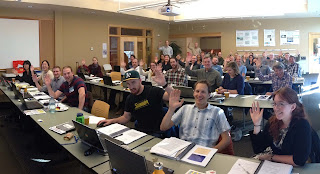Fort Collins in October is a great place to be. Not only because of the peak fall colors and the freedom to drive around without traffic, but also because October marks the time of year when Midwest GeoSciences Group and In-Situ, Inc collide universes to conduct a 2-day aquifer testing course that has become the Go-To educational experience for aquifer testing.
2015 is the 10-year milestone for conducting the 2-day aquifer testing course at In-Situ, Inc and on behalf of the instructors and our In-Situ hosts, THANK YOU TO THE PARTICIPANTS to attend. Thank you to all of those who have attended during the past 10 years, and especially those who have attended several times. Your professionalism, enthusiasm, and positive energy make the course an enriching experience for learning and technical mastery.
In-Situ, Inc is the center of the universe in terms of transducers and dataloggers for aquifer testing, so the course location is the perfect fit. Course participants get an inside look at the inner sanctum of manufacturing, production and distribution at the exact place where our equipment is made and shipped. Thank you to all In-Situ staff for making the tours a fun and fruitful event. -Dan
30 October 2015
02 October 2015
Full-Day Course at the 2015 AEG Annual Meeting: Getting to the Core!!
Thanks to all of the 2015 AEG Annual Meeting attendees in Pittsburgh! It was a fun and fruitful meeting with a grand finale ending from teaching a full-day day short course dedicated to Characterization of Rock Core and Borehole Conditions!
Organized by Gary Rogers from Schnabel Engineering with support from myself and John Stowell at Mt. Sopris Instruments and Mike Need at Ruen Drilling, the course gave insights to a spectrum of applications in rock coring and borehole tools.
The course was indeed unique because it was like a merging of two universes: geotechnical and hydrogeologic. Project objectives differ between the two disciplines which may be over-generalized as "bulk strength and rock mass stability" for geotechnical projects and "ground water movement" for hydrogeologic projects. Each application share similar approaches, terminology and tools, but there is an obvious separation of background, tradition, and application. I enjoyed learning new attributes about how RQD applies to rock strength that will soon be incorporated in the FIELD GUIDE FOR ROCK CORE LOGGING AND FRACTURE ANALYSIS.
Thank you to the course participants. You made the course fun and memorable for the instructors...and equally important, your input during discussion enriched the entire course experience. It is always amazing to me whenever we teach a MidwestGeo course (and AEG course in this case) to learn about the powerful experience that is present in the classroom and the wonderful personal pride people have in their work. I tip my hat to you. -Dan
Organized by Gary Rogers from Schnabel Engineering with support from myself and John Stowell at Mt. Sopris Instruments and Mike Need at Ruen Drilling, the course gave insights to a spectrum of applications in rock coring and borehole tools.
The course was indeed unique because it was like a merging of two universes: geotechnical and hydrogeologic. Project objectives differ between the two disciplines which may be over-generalized as "bulk strength and rock mass stability" for geotechnical projects and "ground water movement" for hydrogeologic projects. Each application share similar approaches, terminology and tools, but there is an obvious separation of background, tradition, and application. I enjoyed learning new attributes about how RQD applies to rock strength that will soon be incorporated in the FIELD GUIDE FOR ROCK CORE LOGGING AND FRACTURE ANALYSIS.
Thank you to the course participants. You made the course fun and memorable for the instructors...and equally important, your input during discussion enriched the entire course experience. It is always amazing to me whenever we teach a MidwestGeo course (and AEG course in this case) to learn about the powerful experience that is present in the classroom and the wonderful personal pride people have in their work. I tip my hat to you. -Dan
Subscribe to:
Posts (Atom)







